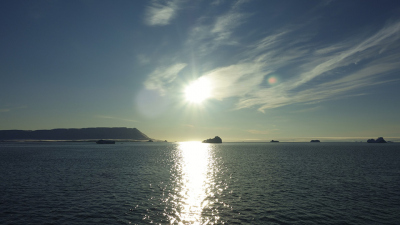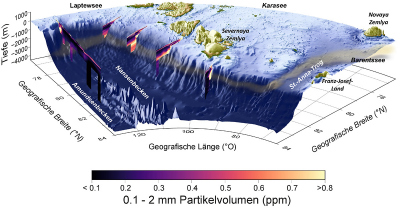- Home
- Discover
- Media Releases
- Media Releases 2022
- biological cabon pump
Arctic Carbon Conveyor Belt Discovered

Compared to other oceans, the biological productivity of the central Arctic Ocean is limited, since sunlight is often in short supply – either due to the Polar Night or to sea-ice cover – and the available nutrient sources are scarce. Consequently, microalgae (phytoplankton) in the upper water layers have access to less energy than their counterparts in other waters. As such, the surprise was great when, on the expedition ARCTIC2018 in August and September 2018 on board the Russian research vessel Akademik Tryoshnikov, large quantities of particulate – i.e., stored in plant remains – carbon were discovered in the Nansen Basin of the central Arctic. Subsequent analyses revealed a body of water with large amounts of particulate carbon to depths of up to two kilometres, composed of bottom water from the Barents Sea. The latter is produced when sea ice forms in winter, then cold and heavy water sinks, and subsequently flows from the shallow coastal shelf down the continental slope and into the deep Artic Basin.
The study is also important for the Cluster of Excellence "The Ocean Floor" based at MARUM. One of the scientific objectives is to decipher the material fluxes and here more precisely the biological carbon pump. “We were very surprised about the large amount of carbon that is laterally injected into the deep ocean in the Arctic. This is a carbon export mechanism that has so far been overlooked and it seems that slow sinking organic matter plays a larger role for carbon storage in the ocean and therefore for climate change mitigation than expected”, says Co-author Morten Iversen who is affiliated with AWI, MARUM and the University of Bremen. “We are continuing to investigate the role of lateral carbon injection in other oceanic regions as collaboration between the Excellence cluster's research unit RECEIVER and the AWI.”

Andreas Rogge, Markus Janout, Nadezhda Loginova, Emilia Trudnowska, Cora Hörstmann, Claudia Wekerle, Laurent Oziel, Vibe Schourup-Kristensen, Eugenio Ruiz-Castillo, Kirstin Schulz, Vasily V. Povazhnyy, Morten H. Iversen, Anya M. Waite: Carbon dioxide sink in the Arctic Ocean from cross-shelf transport of dense Barents Sea water (2022). DOI: https://doi.org/10.1038/s41561-022-01069-z
More Information:


